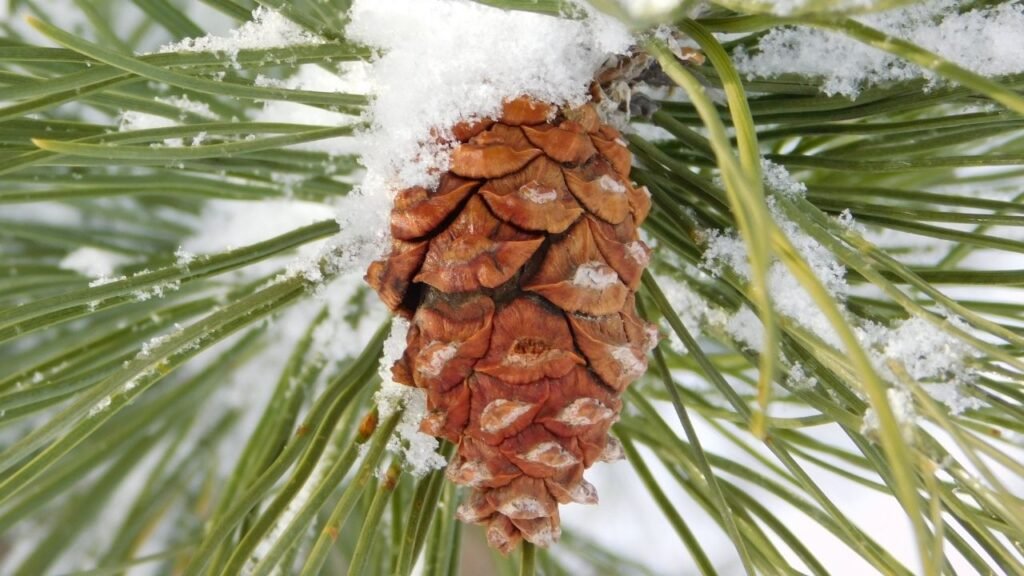Are Pine Needles Toxic For Dogs? Pine needles can cause mild toxicity in dogs if ingested, leading to gastrointestinal upset like vomiting or diarrhea.
As a dog owner, your pet’s health and safety are always a top priority.
Dogs are curious creatures, and their love for exploring the outdoors often leads them into contact with various plants and environmental elements, including pine needles.
Whether you have pine trees in your yard or encounter them on walks through forested areas, it’s important to understand whether these needles pose a risk to your dog’s health.
While pine needles may not be the most dangerous item your dog can ingest, they do come with potential hazards.
This blog post will explore the possible effects of pine needles on dogs, how to prevent ingestion, and what to do if your dog consumes them.
Contents
What Are Pine Needles?
Types of Pine Trees
Pine trees are coniferous evergreen trees that are part of the Pinaceae family, with over 100 species found worldwide. [Are Pine Needles Toxic For Dogs?]
These trees are well-known for their long, slender needles and pine cones, which grow in various shapes and sizes depending on the species.
Common types of pine trees that dog owners might encounter include:
- Eastern White Pine (Pinus strobus): Known for its soft, flexible needles and long cones, this species is native to eastern North America.
- Loblolly Pine (Pinus taeda): Common in the southeastern United States, this tree has thick, stiff needles that are often found littering the ground in forests and yards.
- Scots Pine (Pinus sylvestris): A hardy tree native to Europe and Asia, the Scots pine is often used in landscaping and holiday decorations.
- Ponderosa Pine (Pinus ponderosa): Popular in western North America, this species produces long, thick needles that can be hazardous to dogs.
Each of these trees sheds its needles throughout the year, though fall and winter tend to see the greatest accumulation. [Are Pine Needles Toxic For Dogs?]
As these needles fall to the ground, they can be easily accessed by curious dogs, especially those that enjoy chewing on foreign objects.
Where Are Pine Needles Commonly Found?
Pine trees are common in many environments, from rural forests to urban parks and residential neighborhoods.
They thrive in a variety of climates and soil types, making them a frequent sight in backyards, public spaces, and even as Christmas trees during the holiday season.
For dog owners, this means that pine needles can often be found in areas where their pets roam. [Are Pine Needles Toxic For Dogs?]
The needles accumulate on the ground, sometimes hidden beneath piles of leaves or snow, making them an easy target for dogs who like to sniff and chew on things during their walks.
In colder regions, pine trees are particularly abundant, shedding needles throughout the year but especially in the fall. [Are Pine Needles Toxic For Dogs?]
As the weather cools and the ground becomes covered in these sharp, slender leaves, dogs may find themselves stepping on or even ingesting them, leading to potential health issues.

Are Pine Needles Toxic For Dogs?
Potential Toxicity
The question of whether pine needles are toxic to dogs is complex. Pine needles contain oils and resin that can cause mild toxicity when ingested.
The resin is primarily responsible for the irritation, and while the toxicity is not typically life-threatening, it can lead to gastrointestinal discomfort.
Ingesting pine needles can result in vomiting, diarrhea, drooling, and lethargy, all of which can make your dog feel unwell for several hours or even days.
Although the toxicity level is generally considered mild, it’s important to note that each dog may react differently based on factors such as size, breed, and overall health.
Smaller dogs or dogs with pre-existing health conditions may be more susceptible to the effects of pine needle ingestion.
If a large quantity of needles is consumed, the risk of more severe symptoms, such as dehydration from vomiting or diarrhea, increases.
Physical Hazards
Beyond mild toxicity, the sharp and rigid structure of pine needles poses physical risks to your dog’s health. [Are Pine Needles Toxic For Dogs?]
Pine needles are long, thin, and pointed, making them capable of puncturing or scratching the tissues in a dog’s mouth, throat, and digestive tract.
When swallowed, the sharp ends of the needles can cause internal injuries that may lead to pain, swelling, and even infection.
One of the most significant risks associated with pine needle ingestion is the potential for gastrointestinal blockages. [Are Pine Needles Toxic For Dogs?]
Dogs that consume a large quantity of pine needles are at risk of developing blockages in their intestines, which can be life-threatening and may require surgical intervention.
The stiff, fibrous nature of the needles makes them difficult for a dog’s digestive system to process, and blockages can occur if the needles accumulate in the stomach or intestines.
Common Symptoms of Pine Needle Ingestion
If your dog ingests pine needles, you may notice several symptoms that indicate they are experiencing discomfort or distress. Common signs include:
- Vomiting: Your dog may attempt to vomit the needles back up as a way to expel the irritants from their system.
- Diarrhea: Ingested pine needles can irritate the stomach and intestines, leading to loose stools or diarrhea.
- Drooling: Dogs may drool excessively if the pine needles have caused irritation in their mouth or throat.
- Lethargy: A dog that feels unwell after eating pine needles may appear more tired or less energetic than usual.
- Loss of Appetite: If the needles have caused discomfort or internal irritation, your dog may refuse to eat or drink.
- Abdominal Pain or Swelling: Internal injuries or blockages caused by pine needles can result in abdominal discomfort, which your dog may express through whining, panting, or restlessness.
If your dog exhibits any of these symptoms, it’s essential to monitor their condition closely. [Are Pine Needles Toxic For Dogs?]
In many cases, mild symptoms will resolve on their own within a few hours, but if the symptoms persist or worsen, contact your veterinarian for advice.
How To Prevent Pine Needle Ingestion
Supervising Your Dog Outdoors
The most effective way to prevent your dog from ingesting pine needles is to supervise them closely while they’re outdoors. [Are Pine Needles Toxic For Dogs?]
Whether in your backyard, at a park, or on a walk, keeping an eye on your dog’s behavior can help you intervene if they start chewing on something potentially harmful.
If you notice your dog showing interest in pine needles, use commands like “leave it” or “no” to discourage them from eating the needles.
In your own yard, consider regularly raking and removing fallen pine needles, especially during the fall and winter months when pine trees shed the most.
This simple step can reduce the risk of your dog encountering and ingesting the needles while playing or exploring.
Alternative Pet-Friendly Landscaping
If you live in an area where pine trees are prevalent or have them in your yard, creating a dog-safe environment can help prevent ingestion.
Consider fencing off areas where pine needles accumulate or using pet-friendly landscaping options. [Are Pine Needles Toxic For Dogs?]
Dog-friendly plants, shrubs, and grasses can provide a safe space for your pet to enjoy the outdoors without the risk of ingesting toxic or harmful materials.
Some safe alternatives for landscaping include:
- Dog-friendly grasses such as Bermuda grass or Zoysia grass, which are soft and non-toxic.
- Herb gardens with safe options like rosemary, basil, or parsley.
- Shrubs like boxwood or hibiscus, which are non-toxic and provide a lush, green environment without posing a threat to your dog.
What To Do If Your Dog Eats Pine Needles
Immediate Steps
If you suspect your dog has eaten pine needles, the first step is to remove them from the area to prevent further ingestion.
Make sure your dog has access to plenty of fresh water, as hydration is essential for flushing out toxins and soothing the digestive system.
Keep a close eye on your dog’s behavior, looking for signs of distress such as vomiting, diarrhea, or lethargy.
In cases where only a small amount of pine needles was consumed, your dog may pass the needles without any significant issues.
However, it’s essential to continue monitoring them for any changes in behavior or symptoms. [Are Pine Needles Toxic For Dogs?]
When To Contact A Vet
If your dog shows any of the following signs after ingesting pine needles, it’s time to contact your veterinarian:
- Persistent vomiting or diarrhea lasting more than 24 hours
- Severe lethargy or weakness
- Signs of abdominal pain, such as whining, panting, or restlessness
- Blood in vomit or stool
- Refusal to eat or drink for more than a day
Your vet may recommend bringing your dog in for an examination, especially if there’s concern about a possible blockage or internal injury.
In some cases, diagnostic imaging such as X-rays or ultrasounds may be necessary to assess the extent of the problem. [Are Pine Needles Toxic For Dogs?]
If a blockage is found, surgery may be required to remove the pine needles and prevent further complications.
Final Verdict: Are Pine Needles Toxic For Dogs?
While pine needles are not considered highly toxic to dogs, they can still cause significant health issues if ingested. [Are Pine Needles Toxic For Dogs?]
From mild gastrointestinal upset to the risk of internal injury or blockages, pine needles pose both chemical and physical hazards to your pet.
By supervising your dog outdoors, regularly cleaning up pine needles, and creating a pet-safe environment, you can reduce the risk of your dog encountering and ingesting these potentially harmful needles.
Always keep an eye out for symptoms of distress, and don’t hesitate to consult your veterinarian if your dog exhibits any concerning signs.
See Also: Is Chapstick Bad For Dogs? Important Facts
FAQs
Are all pine trees dangerous for dogs?
While not all pine trees are equally toxic, most species can cause mild gastrointestinal upset or physical injury if their needles are ingested by dogs.
Can pine needle ingestion cause long-term harm?
Ingesting a small number of pine needles usually causes temporary discomfort, but larger amounts can lead to more serious health issues, including blockages that may require surgery.
What should I do if my dog frequently eats plants?
If your dog has a habit of eating plants or other non-food items, it’s important to train them to avoid this behavior and provide them with safe alternatives such as chew toys.
Are pine cones also harmful to dogs?
Yes, pine cones can present a choking hazard or cause intestinal blockages if ingested. The resin on pine cones can also irritate your dog’s digestive system.
Can pine essential oils harm dogs?
Yes, pine essential oils can be toxic to dogs if ingested or applied to the skin, leading to symptoms like vomiting, drooling, and difficulty breathing. [Are Pine Needles Toxic For Dogs?]

Derrick Wilcox is a certified canine behaviorist with over 12 years of experience at Happy Paws Animal Clinic and Pawsitive Training Center, helping pet owners ensure safer, healthier, and happier lives for their dogs.



